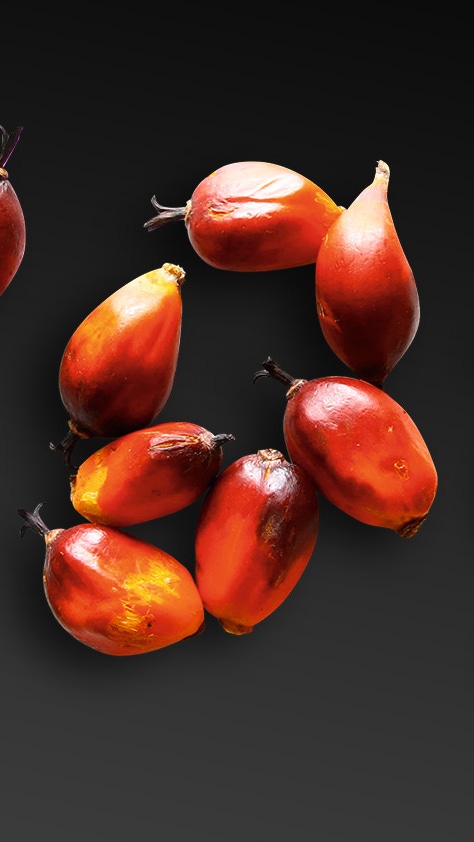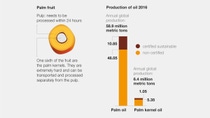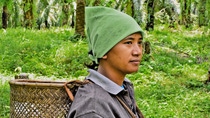Novice in mediji
The palm oil challenge
Palm oil: It’s in everything from pizza and margarine to cosmetics and detergents. Demand for palm oil has grown fast – but the costs for rain forests, animals and local people are high. As the industry works to improve sustainability, we ask what progress has been made and what needs to happen next to protect the environment and people.
“I have witnessed the struggle of the elder generations to stand up against companies who wanted to take over the forest and convert it into oil palm estates. Now I preserve the forest for the sake of future generations.” Arifin is a forest keeper in West Kalimantan, Indonesia. Deforestation, displaced communities, destruction of the natural habitats of rare species – the impact of palm oil production has caused widespread public concern in recent years and even sparked calls to boycott palm oil products.
Why is palm oil so important?
Yet palm oil remains the most widely consumed vegetable oil in the world, found in half of all packaged products. In the decade from 2003 to 2013, global demand for palm oil more than doubled and since then has continued to rise. No wonder. It’s versatile, easy to process, and yields per hectare of land are much higher than sunflower, rapeseed and other vegetable oils. It helps feed a growing world population and gives work to millions of small farmers. In addition, palm kernel oil also has unique chemical properties which make it an important renewable raw material.
An urgent dilemma
How do we meet rising demand in a way that protects the environment and respects the rights of local peoples? Through the Roundtable on Sustainable Palm Oil (RSPO) certification process, some progress has been made, yet still a good 80 percent of palm oil in the global supply chain comes from non-certified production. What needs to happen next? We asked key players along the value chain how we can turn this challenge around.
The retailer
It starts in the supermarket, like ALDI SOUTH, where many of the products people buy every day contain palm oil or ingredients produced from it.

Manager, Corporate Responsibility International, ALDI SOUTH, Mülheim/Ruhr, Germany
“Most of the palm oil we use is in food products. Switching to other oils is often no more sustainable, it just shifts the problem. Since 2015, all our own-brand food products in Germany, Austria, Switzerland, the United Kingdom, Ireland and Australia are certified under one of the three RSPO supply chain models. In other countries, where the availability of certified palm oil is still limited, we are working to reach this goal by the end of 2018. We don’t label many products in store with the RSPO certificate. Some contain only tiny amounts and consumers already face multiple labels that we do not wish to add to unnecessarily. Also, palm oil is only one of the topics we are addressing; we have a team of over 40 people working on corporate responsibility issues. In the end, we want our customers to rely on us to provide products that are sustainable. That should be the baseline. Our aim is for 100 percent sustainable palm oil in all products. The reality is that the last 20 percent is always hard. It’s a question of how far you can push the market. Collaboration with suppliers and engagement in multi-stakeholder initiatives is essential, but pre-competitive collaboration with other retailers is also very important as we are all facing the same issues.”
The manufacturer
Beauty products manufacturer L’Oréal uses palm oil and its derivatives to make products such as lipsticks and shampoos. To ensure its products will not contribute to deforestation, it is tracing palm derivatives back to their origin.

Chief Corporate Responsibility Officer, L’Oréal, Clichy, France
“We want to reassure our consumers that the issues they are concerned about also concern us. Palm oil is high up that list. We see it as our responsibility to work with our suppliers and be a force for change. The first step is knowing where our palm oil comes from, so we have invested heavily in traceability. This means working on the ground with independent organizations to trace it back and evaluate the source for environmental and social factors. Nothing is as valuable as going into the field. The biggest challenge is the huge number of players involved from the moment the fruit is picked to when it reaches us. We haven’t achieved 100 percent traceability yet – it’s an ongoing process – but the more we know, the more influence we can have. Today, consumers expect this level of transparency. It is what retailers ask of us and what we ask of our suppliers. What is required next is a collective will to drive through change in the sector for deforestation-free and responsible palm production.”
The plantation owner
Golden Agri-Resources is the leading palm oil plantation group in Indonesia and one of the largest palm oil companies in the world.

Vice President, Corporate Communications and Sustainability Relations, Golden Agri-Resources, Singapur
“A lot of pressure to protect the environment comes from E.U. customers and NGOs, but for us it is a working reality. You can’t be in agribusiness for the long term if you don’t take care of the environment you rely on to grow your produce, and if you feed distrust and resentment in rural communities, you won’t be successful. The palm plant is there for 20 to 28 years. We have to take a longterm perspective. In 2016, we said we would trace our palm oil back to the point of origin. Meeting our commitment will not be easy. We employ 170,000 people across Indonesia and deal with thousands of independent farmers, many without email or 3G phones. Yet somehow we want them to understand what these requirements are about and to inspire them. We are also involved in complex negotiations with people from local communities who are very poor and see setting aside a conservation area as a barrier to their own development. Getting informed consent is essential. We are glad to see that others in the industry are investing in these changes, too. There is a real momentum and a desire to work together to achieve sustainability.”
The campaigner
In Indonesia, the non-governmental organization Greenpeace campaigns to prevent further destruction of the rainforest to protect biodiversity, local communities and the environment.

Forest Campaigner, Greenpeace Indonesia, Jakarta, Indonesia
“Big companies have woken up to the environmental costs of the palm industry. These are nowhere more evident than in Indonesia. In 2015, we had the worst forest fires for almost 20 years as a result of decades of forest destruction. The question remains, is the industry doing enough? We’re not against palm oil or the palm oil industry per se. Yet while most big companies have adopted sustainability policies, unsustainable palm oil is still making its way into their supply chains through small and mediumsized firms involved in forest destruction and human rights abuses. These firms need to either compensate for their damages in a timely manner or be entirely cut off from the market. To achieve this, companies have to ask the right questions of their suppliers. For that, they need to fully understand their supply chain and must take action. Suppliers who continue to breach commitments must realize there is a big price to pay. The industry can and must enforce these commitments along the supply chain, even with growing demand. It is critical to break the link between palm production and environmental damage.”
The chemical company
BASF offers ingredients used to produce cosmetics and home and personal care products. A key raw material for these ingredients is palm kernel oil.

Senior Vice President BASF Personal Care Europe, Düsseldorf and Monheim, Germany
“Demand for natural cosmetics and personal care products has boomed over the last ten years. Few people realize that this success story is largely built on palm kernel oil. To understand why, you need to take a deep dive into its chemistry. Compared to many other vegetable oils, it has almost unique lines of connected carbon atoms – the c-chains. The mid-cut chains produce foaming effects; the short chains are perfect for moisturizing and smoothing effects. We fractionate the oil into its different c-chain lengths and add functional groups to obtain the desired performance. The oil goes through up to 10 different processes to get the final ingredient, be it a surfactant or an emollient for moisturizers. This is how we are able to offer ingredients for natural cosmetics based on renewable resources. But one more step is needed to make these renewable resources sustainable: certification. This gives users certainty that oil comes from plantations and mills that protect forests, biodiversity and the rights of people living there. We need all the stakeholders to support the RSPO standard and strictly implement its rules. Our ultimate goal is to have only certified and sustainable palm kernel oil in the value chain.”
The growth dilemma
In demand: Global consumption of palm oil and palm kernel oil has grown rapidly from about 4 million metric tons in the late 1970s to some 70 million tons today. Major changes in consumer behavior, population growth and energy politics have been the key drivers.
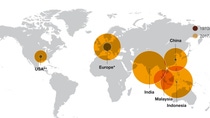
*1970/71: Belgium, Luxembourg, Denmark, France, West Germany, Ireland, Italy, Netherlands, Sweden, UK.
2017/18: EU27
** Palm oil consumption in the U.S. is relatively low due to the use of other vegetable oils.
Major users
Consumption: Population growth, increasing incomes and urbanization, substitution for vegetable oils with lower yield, and use in biofuel have driven palm oil demand. Global palm oil consumption has doubled every 10 years since the 1960s. In 2007, palm oil became the world’s dominant vegetable oil.

Land use
Growth limit: Some 95 percent of existing palm oil plantations are located in a latitude range of 10° north and south of the Equator. Although productivity is growing, growth rates may fall: Scientists see climate becoming unsuitable for growing oil palm in many tropical regions, especially after 2050.
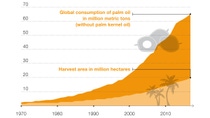
2050 Growth estimates
Global population: over 9 billion
Required increase in food production: 70 percent more than in 2005
Demand for palm oil: By 2050, 264 to 447 million metric tons may be needed worldwide. Indonesia could cover roughly half of the demand.
Sources: United States Department of Agriculture; BASF estimates; RSPO Impact report 2016; USDA 2011; Afriyanti et al., 2016; Paterson et al., 2017; FAO, 2009; Corley, 2009; Oil World Global Research and Analysis
